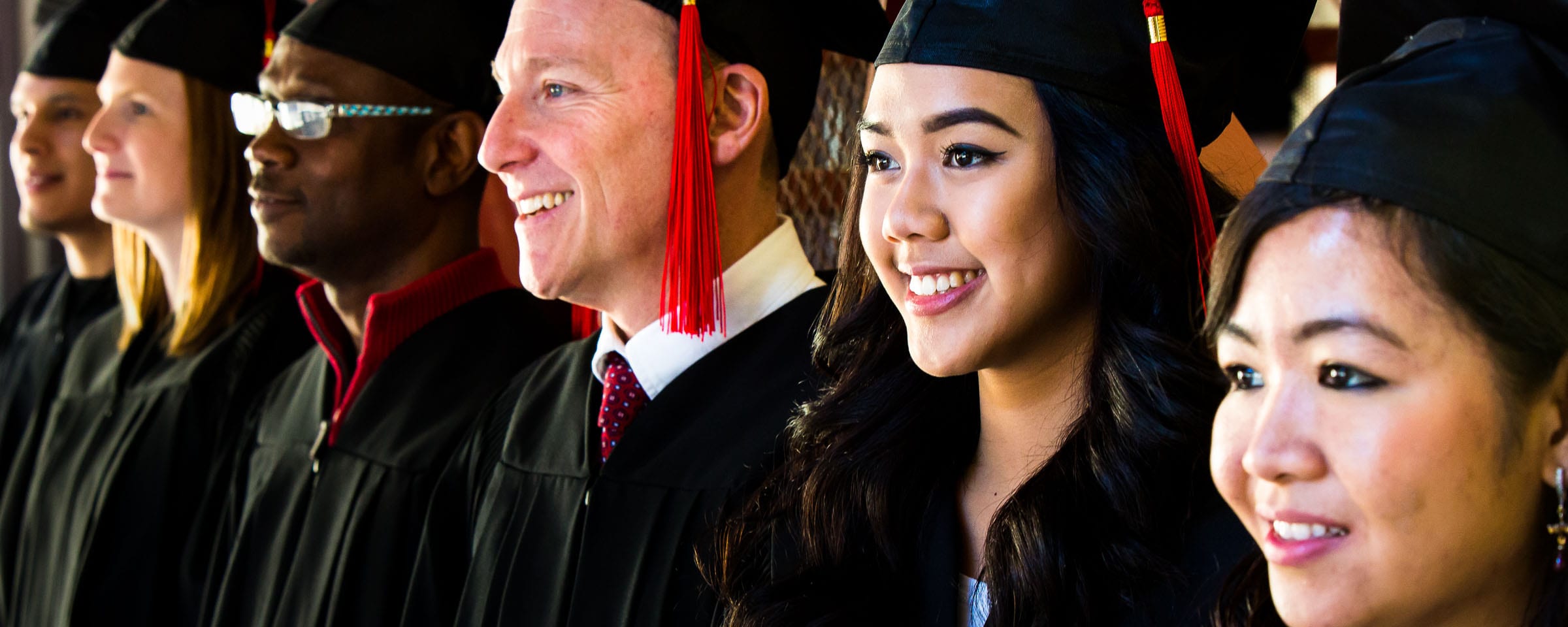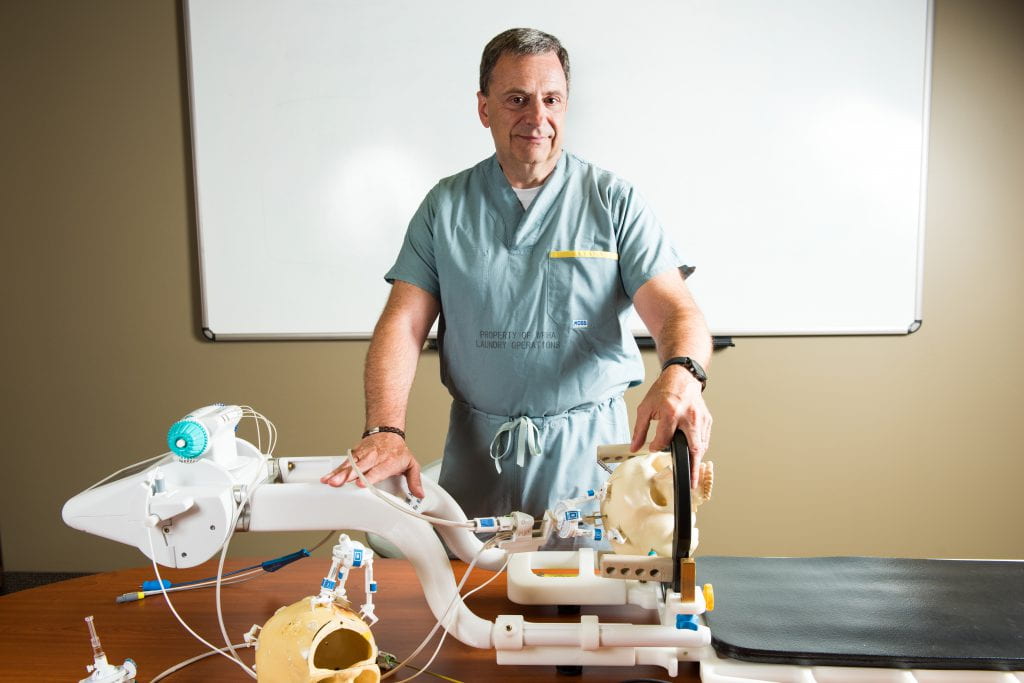Inventing hope: Distinguished alum’s breakthrough helps doctors target brain tumours
 Thirty years ago, Dr. Mark Torchia started tinkering with an idea that had life-saving potential — a tool that could destroy inoperable brain tumours.
Thirty years ago, Dr. Mark Torchia started tinkering with an idea that had life-saving potential — a tool that could destroy inoperable brain tumours.
The seed was planted during a conversation with neurosurgeon Dr. Michael West at St. Boniface Hospital. A short time earlier, West had used a minimally invasive procedure to access a brain tumour and collect a sample for biopsy. To Torchia, it seemed logical to expand on that idea to deliver a killing blow to the target tissue.
“Taking the idea and turning it into something viable is where the challenge arises,” he explains. “It was one of those situations where the idea was there, but the core technology that was going to be required to really bring the idea to fruition didn’t exist.”
A 1995 recipient of Red River College’s Distinguished Alumni Award, Torchia and engineer Richard Tyc eventually met the challenge, developing the NeuroBlate System at the St-Boniface Hospital Albrechtsen Research Centre and in 1999, founding Monteris Medical Inc. to take it to market.
Using magnetic resonance imaging (MRI) as a visual guide, the complex system lets neurosurgeons insert a laser probe into the brain and destroy tumours without damaging surrounding tissue.
Approved for use in the U.S. in 2009, the system was first used in Canada in 2015. It’s now available in some 45 hospitals in the U.S. and in three Canadian hospitals — in Vancouver, Toronto and Montreal. Torchia says it’s only a matter of time before it’s available in Winnipeg.
The invention earned Torchia and Tyc a $100,000 Principal Award from the Ernest C. Manning Awards Foundation in 2015, and one of six inaugural Governor General’s Innovation Awards in 2016.
But the real reward is in knowing that so far, more than 1,000 patients have been given a new lease on life.
“It’s hard not to smile when you hear about the patients’ stories or witness the patients’ stories first-hand,” Torchia says.
Those stories are growing in number, as neurosurgeons adopt the system and find new ways to use it for patients with different types of tumours and even epilepsy.
When Torchia was invited to speak about the evolution of the technology at a NeuroBlate Network meeting in January, it was a dramatically different experience from his first such meeting, when he tried to convince a handful of attendees that it might actually have positive impact.
“And then I was the first speaker at the last meeting and there were 65 or 70 neurosurgeons in the audience listening to the history of the thing. It’s quite surreal, but it’s great,” he says.
“The goal here is improving patient outcomes and if we can do something to impact and provide a reasonable quality of life for people with really difficult diseases, well then we’ve done our job.”
An associate professor of surgery in the Max Rady College of Medicine at University of Manitoba, and executive director of the UM Centre for the Advancement of Teaching and Learning, Torchia began his career at St. Boniface Hospital as a principal investigator in the Department of Surgery laboratory, landing that job immediately after graduating from RRC’s two-year Biochemical Technology program in 1978.
He had completed a year of pre-med studies at the U of M when he decided RRC’s hands-on approach to learning was a better fit for his career goals at the time.
While his mother, Win Torchia, later worked at RRC — as department head of women’s programs, she encouraged women to pursue non-traditional careers — it was another woman who first drew Torchia’s attention to the college.
His girlfriend – now his wife, Barbara (nee Balon) — was in the Medical Laboratory Technology program, from which she graduated in 1977. They attended an open house together and, through her, he had other opportunities to check out RRC’s laboratory facilities.
“And just because I am immediately attracted to flashing lights and beeping buttons and things like that — I think that was probably not the only draw, but I think it introduced me to the idea that this might be something in the near-term that would be a good place for me,” he says.
“I knew I wanted to do something in medicine. I knew I wanted to do something that could impact patient care. I knew that my skills were in science and math and, although I didn’t define it then, in engineering. Basically I was a tinkerer and … I wanted to take that ability and translate it into something that could be useful.”
Mission accomplished. Torchia earned his MSc and PhD from the Faculty of Medicine at the U of M while working full-time at St. Boniface Hospital and he’s put his education to work on several useful projects.
Besides co-authoring a couple of medical textbooks related to one of his specialties, human embryology — which he teaches at the university — he has also patented many health care-related inventions. His first, an automated device for collecting samples of bodily fluid, was made with a valve used in air conditioning systems, linked to a computer controller.
He later co-developed an automated system to quickly and safely prepare contaminant-free medications for IV bags and syringes. Called RIVA (robotic intravenous automation), it’s used for chemotherapy and other applications.
While he’s no longer with St. Boniface Hospital, Torchia was inducted into its Research Hall of Fame last year. He could rest on his laurels as he approaches retirement age, but he says he and Barbara are both committed to using their brainpower.
Many years ago, he encouraged RRC students to make a similar commitment when he sat on a College curriculum committee.
“I went in and talked to students about potential career paths using mine as an example, which is probably really a bit freakish, ” he says. “But nonetheless, opportunities exist out there and I think it’s important to remind people that it’s not just about the courses that you take; it’s how you apply that knowledge that you’ve been given and those skills.”
“I think Red River College provides an opportunity for students to get some really important fundamental knowledge, experience and training that they can apply throughout their lives.
“Look at me — I think about all the crazy and wonderful things that have happened. A lot of that has resulted from that core knowledge that I gathered at Red River so I’m always thankful for that. I took it and built something with it and I think everybody should hopefully be rewarded with an experience like that because it’s certainly life-changing.”
— Profile by Pat St. Germain (Creative Communications, 1989)
(Photo courtesy the University of Manitoba)

